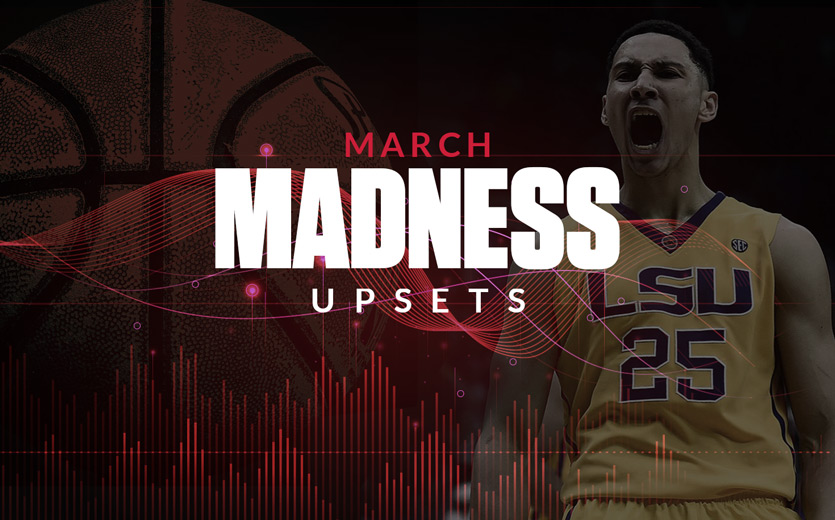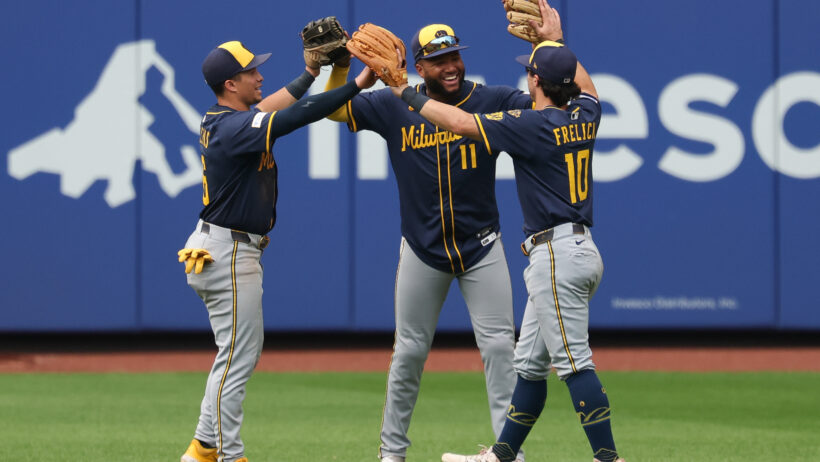March Madness Upsets: How to Spot Them with These Integral Trends
By Sascha Paruk
Updated:

- Watching favorites fall in March Madness is all the more exciting when you have money on the underdog.
- Looking at past results, we examine some commonalities among NCAA Tournament upsets.
- Don’t get attached to that highly-ranked mid-major.
March Madness has such a broad allure, in part, because of the prevailing feeling that anything can happen. That feeling became all the more prevalent after UMBC, a #16 seed, demolished #1 overall seed Virginia in 2018, dropping the all-time record of #1s to 135-1.
While it’s easy to predict that there will be chaos in the bracket every year, it’s a lot harder to pinpoint where the chaos will arise. Is there any way to spot March Madness upsets-in-the-making with 100% accuracy? Of course not. But looking at past results, there are certain identifiable traits and trends that are present in an alarming number of NCAA Tournament upsets.
Here are the four trends our research has identified.
NB: in this article, the term “Power Six conferences” refers to the ACC, Big 12, Big East, Big Ten, Pac-12, and SEC.
- BETMGM SPORTSBOOK
USE CODE SBD1500 & GET $1,500 BACK IN BONUS BETS
- BET365 SPORTSBOOK
BET $5 & GET $150 IN BONUS BETS WITH CODE DIME365
- FANATICS SPORTSBOOK
BET & GET UP TO $1,000 IN BONUS BETS!
- DRAFTKINGS SPORTSBOOK
BET $5 & GET $150 IN BONUS BETS INSTANTLY!
- FANDUEL SPORTSBOOK
BET $5 & GET $150 IF YOUR BET WINS
- CAESARS SPORTSBOOK
USE CODE SBD2DYW & BET $1 TO DOUBLE THE WINNINGS ON YOUR FIRST 10 BETS!
Must be 21+. GAMBLING PROBLEM? Call 1-800-GAMBLER (CO, IL, KS, KY, MD, MI, NC, NJ, OH, PA, TN, VA, VT, WV, WY); (800) 327-5050 or gamblinghelplinema.org (MA); (877) 8-HOPENY (NY); 1-800-NEXT-STEP (AZ); (888) 789-7777 (CT); 1-800-BETS-OFF (IA); 1-800-9-WITH-IT (IN); mdgamblinghelp.org (MD); morethanagame.nc.gov (NC); 1800gambler.net (WV)
1. Fade Mid-Majors with a Top-Five Seed
Over the last decade, mid-majors that get a top-five seed have been upset at a startling rate, especially the ones not named Gonzaga.
In the last 11 tournaments, 17 non-Gonzaga mid-majors have received a top-five seed. Seven of those lost in the first round. Nine more lost in the second round, and every one of them lost against the spread (ATS), as well.
| Year | Mid-Majors with a Top-Five Seed | March Madness Result | Score | Spread |
|---|---|---|---|---|
| 2024 | #5 San Diego State | Lost to #1 UConn (Sweet 16) | 82-52 | +11.5 |
| 2024 | #5 Saint Mary’s | Lost to #12 Grand Canyon (Round 1) | 75-66 | -5.5 |
| 2023 | #5 Saint Mary’s | Lost to #4 UConn (Round 2) | 70-55 | +4.0 |
| 2023 | #5 San Diego State | Lost to #4 UConn (Final) | 76-59 | +7.5 |
| 2022 | #5 Houston | Lost to #2 Villanova (Elite Eight) | 50-44 | -3.0 |
| 2022 | #5 Saint Mary’s | Lost to #4 UCLA (Round 2) | 72-56 | +3.0 |
| 2021 | #2 Houston | Lost to #1 Baylor (Final Four) | 78-59 | +5.0 |
| 2019 | #3 Houston | Lost to #2 Kentucky (Sweet 16) | 62-58 | +2.0 |
| 2018 | #2 Cincinnati | Lost to #7 Nevada (Round 2) | 75-73 | -4.5 |
| 2018 | #4 Wichita State | Lost to #13 Marshall (Round 1) | 81-75 | -13.0 |
| 2015 | #5 Northern Iowa | Lost to #4 Louisville (Round 2) | 66-53 | +2.0 |
| 2014 | #5 VCU | Lost to #12 Stephen F. Austin (Round 1) | 77-75 OT | -5.5 |
| 2014 | #5 Cincinnati | Lost to #12 Harvard (Round 1) | 61-57 | -3.5 |
| 2014 | #4 San Diego State | Lost to #1 Arizona (Sweet 16) | 70-64 | +6.5 |
| 2014 | #5 St. Louis | Lost to #4 Louisville (Round 2) | 66-51 | +9.0 |
| 2013 | #5 VCU | Lost to #4 Michigan (Round 2) | 78-53 | +3.0 |
| 2013 | #5 UNLV | Lost to #12 Cal (Round 1) | 64-61 | -3.0 |
| 2013 | #4 St. Louis | Lost to #12 Oregon (Round 2) | 74-57 | -3.5 |
| 2012 | #5 Temple | Lost to #12 USF (Round 1) | 58-44 | -2.0 |
| 2012 | #5 Wichita St | Lost to #12 VCU (Round 1) | 62-59 | -8.5 |
| 2012 | #5 New Mexico | Lost to #4 Louisville (Round 2) | 59-56 | +1.5 |
Before Houston’s run of success in 2021, the only one of these teams that advanced to the Sweet 16 was #4 SDSU in 2014, which went 2-1 ATS in its three games.
Fading these mid-majors on the moneyline in the first round has been profitable. Fading them ATS in each of the first two rounds has been, as well.
2. Nine-Year Trend Says Lookout for #11 Seeds
In general, the better a team’s seed, the less likely it is to lose in the first round. Strictly looking at historical statistics, #1s are less likely to lose than #2s, while #2s are less likely to lose than #3s, and so on.
That holds true for every seed-line, as illustrated in our “Most Common March Madness First-Round Upsets” article.
Though, that wasn’t actually the case until recently. For years, #12 seeds were winning at a higher rate than #11 seeds. But the #11s have been on a tear over the last nine NCAA Tournaments and now have a better all-time win-rate than the #12s (38.1% vs. 34.8%).
Not only have they surpassed #12s in terms of all-time wins in the first round, but with three first-round wins in 2024, they also passed the #10 seeds (60 wins vs 61 wins). More importantly for present purposes, 11 seeds have a 17-15 record over the last eight years.
At least two #11 seeds have advanced to the second round in six of the last eight tournaments, and in 2016 and 2017, three #11 seeds made it to the Round of 32.
The last time the #11 seeds were shutout in the first round was 2004. Compare that to #12s, which went 0-4 in 2007, 2015, 2018.
Obviously, you don’t want to blindly follow a trend from a sample size this small. So is there something causing it that we can get behind?
Here are the last 22 #11 seeds to win in the Round of 64:
Recent #11 Over #6 “Upsets”
| Year | Team | Opponent |
|---|---|---|
| 2024 | #11 NC State | #6 Texas Tech |
| 2024 | #11 Duquesne | #6 BYU |
| 2024 | #11 Oregon | #6 South Carolina |
| 2023 | #11 Pitt | #6 Iowa State |
| 2022 | #11 Michigan | #6 Colorado |
| 2022 | #11 Notre Dame | #6 Alabama |
| 2022 | #11 Iowa State | #6 LSU |
| 2021 | #11 UCLA | #6 BYU |
| 2021 | #11 Syracuse | #6 San Diego State |
| 2019 | #11 Ohio State | #6 Iowa State |
| 2018 | #11 Loyola-Chicago | #6 Miami |
| 2018 | #11 Syracuse | #6 TCU |
| 2017 | #11 Xavier | #6 Maryland |
| 2017 | #11 Rhode Island | #6 Creighton |
| 2017 | #11 USC | #6 SMU |
| 2016 | #11 Wichita State | #6 Arizona |
| 2016 | #11 Northern Iowa | #6 Texas |
| 2016 | #11 Gonzaga | #6 Seton Hall |
| 2015 | #11 UCLA | #6 SMU |
| 2015 | #11 Dayton | #6 Providence |
| 2014 | #11 Tennessee | #6 UMass |
| 2014 | #11 Dayton | #6 Ohio State |
Seven of those matchups (the ones in bold) involve a mid-major team upsetting a Power Six team. Six involve a mid-major on the losing end. If and when you see a solid mid-major against a sub-elite Power Conference team, history says an upset could be in the making.
3. Bet on Teams Rated Higher at KenPom.com than by the Selection Committee
There is always some disparity between the Selection Committee’s seedings, which aim to reward teams for their work to date, and the rankings at KenPom.com (a popular analytics website), which aim to predict future outcomes.
The discrepancies between the two are shrinking, but they still exist. Over the last nine tournaments, 17 teams in KenPom’s top-35 have received an #11 seed or worse. They are 22-17 straight up (including the First Four play-in games) and 18-17 ATS excluding the First Four (where they have tended to be favored, for obvious reasons).
| Year | Team | Seed | KP Rank | Reached (Tourn. Record) |
|---|---|---|---|---|
| 2022 | Virginia Tech | #11 | 19th | First Round (0-1) |
| 2019 | Saint Mary’s | #11 | 31st | First Round (0-1) |
| 2018 | Loyola-Chicago | #11 | 31st | Final Four (4-1) |
| 2017 | Rhode Island | #11 | 34th | Second Round (1-1) |
| 2017 | Xavier | #11 | 31st | Elite 8 (3-1) |
| 2017 | Kansas St. | #11 | 30th | First Round (1-1 incl. First Four) |
| 2016 | Gonzaga | #11 | 21st | Sweet 16 (2-1) |
| 2016 | Wichita State | #11 | 13th | Second Round (2-1 incl. First Four) |
| 2016 | Vanderbilt | #11 | 25th | First Four (0-1) |
| 2015 | BYU | #11 | 28th | First Four (0-1) |
| 2014 | Tennessee | #11 | 11th | Sweet 16 (3-1 incl. First Four) |
| 2014 | Harvard | #12 | 32nd | Second Round (1-1) |
| 2013 | Oregon | #12 | 35th | Sweet 16 (2-1) |
| 2013 | Minnesota | #11 | 20th | Second Round (1-1) |
| 2013 | Ole Miss | #11 | 34th | Second Round (1-1) |
| 2013 | St. Mary’s | #11 | 21st | First Round (1-1 incl. First Four) |
Distilling the information in the table a little further, only five of those teams actually lost in the Round of 64: Saint Mary’s 2013, Kansas State 2017, Saint Mary’s 2019, Virginia Tech 2022 and New Mexico 2024.
If a team is ranked outside of KenPom’s top-100, count to the AAV of Mike Krzyzewski’s salary.
4. Finding #1 and #2 Seeds Ripe for an Upset
Correctly betting on a #1 or #2 seed to lose in the first round will obviously result in a huge return. But it doesn’t happen often, so you have to be very discerning to make this a winning strategy longterm.
There have been just nine #1 and #2 seeds that have been upset since 2001. These teams don’t share any single trait in common (apart from the losing), but there are a couple of things that stand out.
Four (2021 Ohio State, 2013 Georgetown, 2012 Duke, and 2012 Missouri) were ranked 79th or worse in either offensive or defensive efficiency. While three more (2023 Purdue, 2018 UVA, and 2016 MSU) played at incredibly slow tempos.
#1 & #2 Seeds That Suffered 1st-Round Upsets
| Year | Team | KP Off. Rank | KP Def. Rank | KP Tempo Rank |
|---|---|---|---|---|
| 2023 | #1 Purdue | 12th | 24th | 324th |
| 2023 | #2 Arizona | 10th | 39th | 13th |
| 2022 | #2 Kentucky | 5th | 36th | 150th |
| 2021 | #2 Ohio State | 4th | 82nd | 251st |
| 2018 | #1 Virginia | 30th | 1st | 351st |
| 2016 | #2 Michigan State | 2nd | 26th | 254th |
| 2013 | #2 Georgetown | 80th | 4th | 300th |
| 2012 | #2 Duke | 8th | 79th | 108th |
| 2012 | #2 Missouri | 1st | 111th | 152nd |
When trying to identify a #1 or #2 seed that’s vulnerable, look for a team that is considerably weaker at one end of the court and plays slowly.
The reason why slow-tempo teams are more prone to upsets is pretty simple; a slower tempo means fewer possessions, and the fewer possessions there are in a game, the greater the likelihood that a less talented team will be able to play to the level of a high-caliber opponent.
To put it another way, it reduces the number of opportunities for the better team to be better.
It’s not every year that a #1 or #2 seed has an offense/defense that ranks relatively low compared to its top-seeded brethren. But when you see one that does, take a longer look at their matchup in the first round, especially if it’s a team that plays at a plodding pace.
Where to Bet on March Madness
Now that you know some of the hallmarks of March Madness upsets, head over to our sportsbook reviews, find the betting site that’s best for you and try your hand at betting on college basketball at our favorite March Madness betting apps. You can click through our links below to claim March Madness betting promos and build your bankroll.
But always remember: never, ever, under any circumstances wager more than you can afford to lose.
If you’re in search of more statistically oriented March Madness betting tips, head over to our strategy section. We touch on everything from perennial traits of March Madness champions, to key final four trends.

Managing Editor
Sascha has been working in the sports-betting industry since 2014, and quickly paired his strong writing skills with a burgeoning knowledge of probability and statistics. He holds an undergraduate degree in linguistics and a Juris Doctor from the University of British Columbia.




